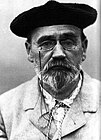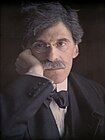Self-portrait
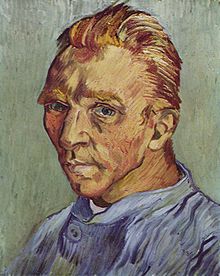
A self-portrait is a
By the Baroque period, most artists with an established reputation at least left drawings of themselves. Printed portraits of artists had a market, and many were self-portraits. They were also sometimes given as gifts to family and friends. If nothing else, they avoided the need to arrange for a model, and for the many professional portrait-painters, a self-portrait kept in the studio acted as a demonstration of the artist's skill for potential new clients. The unprecedented number of self-portraits by Rembrandt, both as paintings and prints, made clear the potential of the form, and must have further encouraged the trend.
Types
A self-portrait may be a
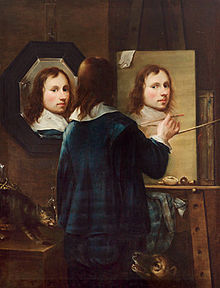
In the earliest surviving examples of medieval and
In the famous Arnolfini Portrait (1434), Jan van Eyck is probably one of two figures glimpsed in a mirror – a surprisingly modern conceit. The Van Eyck painting may have inspired Diego Velázquez to depict himself in full view as the painter creating Las Meninas (1656), as the Van Eyck hung in the palace in Madrid where he worked. This was another modern flourish, given that he appears as the painter (previously unseen in official royal portraiture) and standing close to the King's family group who were the supposed main subjects of the painting.[7]
In what may be one of the earliest childhood self-portraits now surviving,
In the 17th century,
Gallery: Inserted self-portraits
-
Adoration of the Magihas an "inserted self-portrait". The position in the (right) corner, and the gaze out to the viewer, are very typical of such self-portraits.
-
Masaccio inserted self-portrait from the Brancacci Chapel frescoes (as is the Filippino Lippi), 1424–1426.
-
Piero della Francesca as a sleeping soldier in his Resurrection, 1463, fresco, Sansepolcro.[9]
-
Filippino Lippi as a figure in his Martyrdom of Saint Peter, fresco, 1481–82, Brancacci Chapel, Florence. He is at the extreme right of a crowded composition.[10]

Women painters
Almost all significant women painters have left self-portraits, from
-
self-portrait, perhaps the oldest self-portrait of a female oil-painter, though much earlier examples of manuscript painters exist.
-
Sofonisba Anguissola (c. 1532–1625) of Cremona served as court painter to the Queen of Spain, and painted several self-portraits and many images of her family. c. 1556
-
School of Bologna.
-
Self-Portrait as the Allegory of Painting, 1630s, Royal Collection. Note the pulled-up sleeve on the arm holding the brush.
-
Mary Beale, Self-portrait, c. 1675–1680, She became one of the most important portrait painters of 17th-century England, and has been described as the first professional female English painter.
-
Sir Joshua Reynolds.
-
Adélaïde Labille-Guiard, 1785, with two pupils. A "subjects-eye" view of the painter at work. It seems likely that women society portraitists did actually paint wearing fashionable clothes like this.
-
Ancien Régime. At 22, 1782.[12]
-
Marie-Denise Villers, Young Woman Drawing, 1801, thought to be her self-portrait, and her most famous and finest painting. Originally attributed to Jacques-Louis David.[13]
-
Marie Ellenrieder, self portrait, 1819. A German religious artist and the first woman to enter the Academy of Munich.
-
Mary Cassatt was an American portrait painter who specialized in portraits of women and children, 1878.
-
Nazisduring World War II.
-
Gwen John (1902) also mostly painted women and children.
-
Paula Modersohn-Becker, Selbstbildnis am 6 Hochzeitstag ("Self-portrait on her 6th wedding anniversary") 1906. She depicts herself as pregnant, which at that point she never had been.
-
Zinaida Serebriakova, At the Dressing-Table (1909), was among the first female Russian painters of distinction.
-
Ilka Gedő, Double Self-Portrait, 1985. The number of self-portraits on paper is about 370 and there are eight self-portraits in oil.
Antiquity
Images of artists at work are encountered in Ancient Egyptian painting, and sculpture[14] and also on Ancient Greek vases. One of the first self-portraits was made by the Pharaoh Akhenaten's chief sculptor Bak in 1365 BC. Plutarch mentions that the Ancient Greek sculptor Phidias had included a likeness of himself in a number of characters in the "Battle of the Amazons" on the Parthenon, and there are classical references to painted self-portraits, none of which have survived.
Asia
Self-portraits may have a longer continuous history in Asian (mainly Chinese) art than in Europe. Many in the
-
Hakuin Ekaku was a Zen monk, who painted many self-portraits of himself as sages of the past, 1764, Tokyo.
-
Motoori Norinaga, late 18th century, Japan
-
Hokusai, early 19th century, Japan
-
Another Hokusai,Smithsonian
-
Kikuchi Yōsai, 1856–7, Japan.
-
Chen Hongshou, China, 1635
-
Ren Xiong, a member of the Shanghai school, c. 1850
European art

-
Saint Dunstan, then artist-Abbot of Glastonbury, prostrates himself before a giant Christ. Inscribed "Remember, I beg you, merciful Christ, to protect Dunstan, and do not permit the storms of the underworld to swallow me up". Later he became Archbishop of Canterbury. c. 950 (cropped at bottom).
-
Eadwine the Scribe whose self portrait is accompanied by the inscription "I am the chief of scribes, and neither my praise nor fame shall die; shout out, oh my letter, who I may be. By its fame your script proclaims you, Eadwine, whom the painted figure represents, alive through the ages, whose genius the beauty of this book demonstrates. Receive, O God, the book and its donor as an acceptable gift." Canterbury, c. 1150s.
-
Prague Cathedral, where he was master architect and sculptor.
-
Baptisterio, Florenceself portrait, early 15th century
-
Jan van Eyck, Portrait of a Man in a Turban (actually a chaperon), 1433, National Gallery, generally regarded as a self-portrait, which would make it the earliest Western panel portrait after antiquity.
-
Rogier van der Weyden, as Saint Luke, makes a drawing for his painting of the Virgin. Boston, c. 1440.
-
Jean Fouquet, c. 1450, a very early portrait miniature, and if the Van Eyck above is excluded, the oldest individual Western painted self-portrait.
-
Andrea Mantegna, c. 1474, includes himself, as court artist, in his appropriate place in this fresco of the Gonzaga court.
-
Israhel van Meckenem and his wife, engraving c. 1490, the earliest portrait print.
Albrecht Dürer, 1471–1528, the first prolific self-portraitist
-
Dürer at thirteen,Albertina, 1484
-
Dürer at about twenty, 1491–92, drawing, Metropolitan
-
Albrecht Dürer Self-portrait 1493. oil, originally on vellum Louvre, Paris. This is among the earliest known formal self-portraits. He is dressed in Italian fashion, reflecting his international success.
-
Dürer'slast self-portrait, 1500—unmistakably Christ-like
Renaissance and Baroque
The great Italian painters of the Renaissance made comparatively few formal painted self-portraits, but often included themselves in larger works. Most individual self-portraits they have left were straightforward depictions; Dürer's showmanship was rarely followed, although a controversially attributed Self-portrait as David by
Titian's Allegory of Prudence (c. 1565–70) is thought to depict Titian, his son Orazio, and a young cousin, Marco Vecellio.[20] Titian also painted a late self-portrait in 1567; apparently his first. Baroque artist Artemisia Gentileschi's La Pittura (Self-portrait as the allegory of painting) presents herself embodying the classical allegorical representation of Painting, seen in the dramatic mask worn around Gentileschi's neck which Painting often carries. The artist's focus on her work, away from the viewer, highlights the drama of the Baroque period, and the changing role of the artist from craftsperson to singular innovator.[21] Caravaggio painted himself in Bacchus at the beginning of his career, then appears in the staffage of some of his larger paintings. Finally, the head of Goliath held by David (1605–10, Galleria Borghese) is Caravaggio's own.
-
Gentile Bellini, black chalk, 1496 or earlier, Berlin
-
Nuremberg sculptor Adam Kraft, self-portrait from St Lorenz Church, 1490s.
-
Probable self-portrait by Leonardo da Vinci, c. 1512–1515
-
Nicholas Hilliard, self-portrait miniature, 1577
Rembrandt and the 17th century in Northern Europe
In the 17th century, Flemish and Dutch artists painted themselves far more often than before;[citation needed] by this date most successful artists had a position in society where a member of any other trade would consider having their portrait painted[citation needed]. Many also included their families, again following the normal practice for the middle-classes. Mary Beale, Anthony van Dyck and Peter Paul Rubens produced numerous images of themselves, the latter also often painting his family. This practice was especially common for female artists, whose inclusion of their families was often a deliberate attempt to mitigate criticism of their profession causing distraction from their "natural role" as mothers.[21]
Rembrandt drew and painted dozens of self-portraits, as well as portraits of his wife, son, and mistress. At one time about ninety paintings were counted as Rembrandt self-portraits, but it is now known that he had his students copy his own self-portraits as part of their training. Modern scholarship has reduced the autograph count to something over forty paintings, a few drawings, and thirty-one etchings. Many show him posing in quasi-historical fancy dress, or pulling faces at himself. His oil paintings trace the progress from an uncertain young man to the dapper and very successful portrait-painter of the 1630s to the troubled but massively powerful portraits of his old age.[22]
-
A young Rembrandt, c. 1628, when he was 22. Partly an exercise in chiaroscuro. Rijksmuseum
-
Etching and burin, c. 1630. Probably an exercise in capturing facial expressions for larger paintings.
-
Rembrandt in 1632, when he was enjoying great success as a fashionable portraitist in this style.
-
Role-playing in Self-portrait as an oriental Potentate with a Kris, etching, 1634.
-
1640, wearing a costume in the style of over a century earlier. National Gallery
-
Vienna c. 1655, oil on walnut, cut down in size.
-
Again in antique costume, 1658,Oil on canvas Frick Collection. His largest self-portrait, for which a new mirror may have been used.
-
Dated 1669, the year he died, though he looks much older in other portraits. National Gallery, London
After Rembrandt
In Spain, there were self-portraits of
Prolific modern self-portraitists
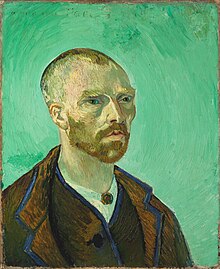
One of the most famous and most prolific of self-portraitists was
The many self-portraits of Egon Schiele set new standards of openness, or perhaps exhibitionism, representing him naked in many positions, sometimes masturbating or with an erection, as in Eros (1911). Stanley Spencer was to follow somewhat in this vein. Max Beckmann was a prolific painter of self-portraits [26] as was Edvard Munch who made great numbers of self-portrait paintings (70), prints (20) and drawings or watercolours (over 100) throughout his life, many showing him being badly treated by life, and especially by women.[27] Obsessively using the self-portrait as a personal and introspective artistic expression was Horst Janssen, who produced hundreds of self-portraits depicting him a wide range of contexts most notably in relation to sickness, moodiness and death.[28] The 2004 exhibition "Schiele, Janssen. Selbstinszenierung, Eros, Tod" (Schiele, Janssen: Self-dramatisation, Eros, Death) at the Leopold Museum in Vienna paralleled the works of Egon Schiele and Horst Janssen, both heavily drawing on sujets of erotica and death in combination with relentless self-portraiture.[29] Frida Kahlo, who following a terrible accident spent many years bedridden, with only herself for a model, was another painter whose self-portraits depict great pain, in her case physical as well as mental. Her 55-odd self-portraits include many of herself from the waist up, and also some nightmarish representations which symbolize her physical sufferings.[30][31]
Throughout his long career, Pablo Picasso often used self-portraits to depict himself in the many different guises, disguises and incarnations of his autobiographical artistic persona. From the young unknown "Yo Picasso" period to the "Minotaur in the Labyrinth" period, to the "old Cavalier" and the "lecherous old artist and model" periods. Often Picasso's self-portraits depicted and revealed complicated psychological insights, both personal and profound about the inner state and well-being of the artist. Another artist who painted personal and revealing self-portraits throughout his career was Pierre Bonnard. Bonnard also painted dozens of portraits of his wife Marthe throughout her life as well. Vincent van Gogh, Paul Gauguin, Egon Schiele and Horst Janssen in particular made intense (at times disturbingly so) and self-revealing self-portraits throughout their careers.
Self-portraits in general
Gallery: painters at work


Many of the medieval portraits show the artist at work, and Jan van Eyck (above) his chaperon hat has the parts normally hanging loose tied up on his head, giving the misleading impression he is wearing a turban, presumably for convenience whilst he paints.[32] In the early modern period, increasingly, men as well as women who painted themselves at work had to choose whether to present themselves in their best clothes, and best room, or to depict studio practice realistically. See also the Gallery of Women painters above.
-
Pieter Brueghel the Elder, The Painter and The Buyer, c. 1565, pen and ink on brown paper, presumed to be a self-portrait. Antwerp
-
Pierre Mignard, 1690, Louvre.
-
Francesco Solimena, c. 1715.
-
François Boucher, self-portrait in the studio, 1720
-
National Portrait Gallery, 1748. The artist as visionary. Much cut down, this originally had a vertical format.
-
George Desmaréesand his daughter, 1750, Munich.
-
Jean-Honoré Fragonard, Self-Portrait with Palette and Brushes, 1769
-
Jean-Baptiste-Siméon Chardin(1771), in his painting clothes.
-
Goya, Self-portrait in the Studio, 1795
-
Gustave Courbet, Artist at His Easel, c. 1847–1848, charcoal on paper
-
Carl Ludwig Jessen, Self-portrait, 1857
-
James Whistler, Self Portrait, c. 1872, Detroit Institute of Arts
-
Vincent van Gogh, Self-Portrait as a Painter, December 1887 - February 1888
-
Henri Rousseau, 1890
-
Jacek Malczewski, Self-portrait with a Palette, 1892
-
Julian Fałat, Self-portrait with a Palette, 1896
-
Anders Zorn, Self-portrait with a Model, 1896
-
Umberto Boccioni, Self-portrait, 1906
-
Enrique Simonet, Self-portrait with a Palette, 1910
-
Ilya Repin, Self-portrait at Work, 1915
-
Henri Matisse, Self-portrait, 1918, Matisse Museum (Le Cateau)
-
Sergio de Castro, Self-portrait with brushes, oil on canvas, 1961
Classification
Art critic Galina Vasilyeva-Shlyapina separates two basic forms of the self-portrait: "professional" portraits, in which the artist is depicted at work, and "personal" portraits, which reveal moral and psychological features. She also proposes a more detailed taxonomy: (1) the "insertable" self-portrait, where the artist inserts his or her own portrait into, for example, a group of characters related to some subject; (2) the "prestigious, or symbolic" self-portrait, where an artist depicts him- or herself in the guise of a historical person or religious hero; (3) the "group portrait" where artist is depicted with members of family or other real persons; (4) the "separate or natural" self-portrait, where the artist is depicted alone. However it might be thought these classes are rather rigid; many portraits manage to combine several of them.[33]
With new media came a chance to create different kinds of self-portraits besides simply static painting or photographs. Many people, especially teens, use social networking sites to form their own personal identity on the internet.[34] Still others use blogs or create personal web pages to create a space for self-expression and self-portraiture.
Mirrors and poses
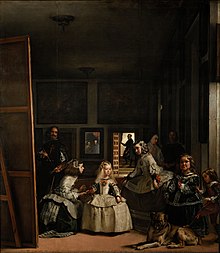
The self-portrait supposes in theory the use of a mirror; glass mirrors became available in Europe in the 15th century. The first mirrors used were convex, introducing deformations that the artist sometimes preserved. A painting by Parmigianino in 1524 Self-portrait in a mirror, demonstrates the phenomenon. Mirrors permit surprising compositions like the Triple self-portrait by Johannes Gumpp (1646), or more recently that of Salvador Dalí shown from the back painting his wife, Gala (1972–73). This use of the mirror often results in right-handed painters representing themselves as left-handed (and vice versa). Usually the face painted is therefore a mirror image of what the rest of the world saw, unless two mirrors were used. Most of Rembrandt's self-portraits before 1660 show only one hand – the painting hand is left unpainted.[35] He appears to have bought a larger mirror in about 1652, after which his self-portraits become larger. In 1658 a large mirror in a wood frame broke whilst being transported to his house; nonetheless, in this year he completed his Frick self-portrait, his largest.
-
Parmigianino, Self-portrait in a mirror c. 1524, is itself painted on a convex surface, like that of the mirrors of the period
-
The Artist's Studio (L'Atelier du peintre): A Real Allegory of a Seven Year Phase in my Artistic and Moral Life, 1855, Musée d'Orsay
-
Ernst Oppler, The painter and Jo, 1928. Selfportrait and portrait
-
Pieter Claesz, Vanitas with Violin and Glass Ball (detail), the artist is visible in the reflection, 1625
The size of single-sheet mirrors was restricted until technical advances made in France in 1688 by Bernard Perrot. They also remained very fragile, and large ones were much more expensive pro-rata than small ones – the breakages were recut into small pieces. About 80 cm, or two and a half feet, seems to have been the maximum size until then – roughly the size of the palace mirror in Las Meninas (the convex mirror in the Arnolfini Portrait is considered by historians impractically large, one of Van Eyck's many cunning distortions of scale).[36] Largely for this reason, most early self-portraits show painters at no more than half-length.
Self-portraits of the artist at work were, as mentioned above, the commonest form of medieval self-portrait, and these have continued to be popular, with a specially large number from the 18th century on. One particular type in the medieval and Renaissance periods was the artist shown as Saint
Gallery: mortality in the self-portrait
-
St. Bartholomew.
-
Allegory of Prudence, Titian, his son and the cousin he had virtually adopted, as Past, Present and Future. National Gallery, London, late 1560s.
-
Van Dyck.
-
Goliath in this late Caravaggio David with the head of Goliath is a self-portrait. 1605–10, Galleria Borghese, Rome.
-
Jan de Bray (left) and his family pose as The Banquet of Anthony and Cleopatra. By the date of this second version of 1669, most of the models had died of the plague some years before.
-
Goyaat the age of 74, Self-portrait with Doctor Arrieta, 1820, Minneapolis.
-
Hippolyte Bayard poses as a drowned man. He lies with his eyes closed, both for the technical reason of the long exposure required by his method and as a protest for the rejection of his claim as inventor of photography.
-
Lovis Corinth, 1896. Flesh and bone, life and death are contrasted here.
Other meanings, storytelling
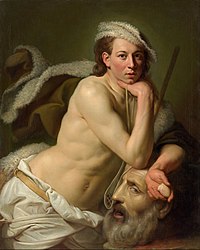
The self-portraits of many
-
Cristofano Allori, Judith with the Head of Holofernes, 1613. According to his biographer, the heads were those of the painter, his ex-lover, and her mother. Compare Caravaggio above.[37]
-
Van Dyck with sunflower, representing his patronage by Charles I, whose medal he holds up to the flower. Or is Van Dyck the sun the flower turns to?[38]1633 or later.
-
Johann Zoffanyspecialised in group portraits, often "conversation pieces" with gentle narrative content, and spent some years in India. c. 1786.
-
Gustave Courbet, 1854, Bonjour, Monsieur Courbet. The artist has travelled to the South of France (in the vanishing coach), to meet the collector Alfred Bruyas, for whom this was painted.[39]
Self-promotion
The self-portrait can be a very effective form of advertising for an artist, especially of course for a portrait painter. Dürer was not really interested in portraits commercially, but made good use of his extraordinary self-portraits to advertise himself as an artist, something he was very sophisticated in doing.
-
François Desportes, a specialist animal painter, Self-portrait as Hunter, 1699.
-
Maurice Quentin de La Tour, pastel, 1750–60.
-
William Orpen, c. 1910
Diagnosing the self-portrait
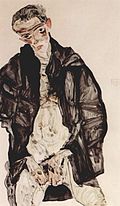
Some artists who suffered neurological or physical diseases have left self-portraits of themselves that have allowed later physicians to attempt to analyze disruptions of mental processes; and many of these analyses have entered into the textbooks of neurology.[3]
The self-portraits of artists who suffered mental illnesses give a unique possibility to physicians for investigating self-perception in people with psychological, psychiatric or neurologic disturbances.
Russian sexologist
Collections
One of the most distinguished, and oldest, collections of self-portraits is in the
Gallery
-
Pietro Perugino, c. 1500
-
Uffizi Gallery
-
Hans Baldung, 1526
-
Titian seems to have painted no self-portraits until he was in old age, 1567
-
Probable self-portrait by El Greco, 1604
-
Peter Paul Rubens, 1623
-
Rubens with his (first) wife Isabella Brant, Munich, c.1609
-
Self-portrait ofFrancisco Zurbarán, as Saint Luke.
Detail of Saint Luke as a Painter Before the Crucifixion -
Salvator Rosa, 1640. "Of Silence and Speech, Silence is better" says the inscription
-
Diego Velázquez, Self-Portrait, 1643
-
Nicolas Poussin, Self-Portrait, 1650
-
Royal Academy, of which he was first President. Rather like Rembrandt, but more successful. 1773
-
Gilbert Stuart, Self-portrait, 1778
-
Francisco Goya, 1815 Oil on panel, Museo de la Real Academia de San Fernando, Madrid
-
Eugène Delacroix, 1837
-
Gustave Courbet, 1842
-
Karl Bryullov, 1848
-
Edgar Degas, Self-portrait, 1855
-
James McNeill Whistler, Portrait of Whistler with Hat, 1858, a self-portrait at the Freer Gallery of Art, Washington, D.C.
-
Henri Fantin-Latour, Self-portrait, 1860
-
Ivan Kramskoi, Self-portrait, 1867
-
Ivan Aivazovsky, Self-portrait, 1874
-
Paul Cézanne, 1880–1881 National Gallery, London
-
Henri de Toulouse-Lautrec, Self portrait, 1882–1883
-
Valentin Serov, 1887
-
Édouard Vuillard, Self-portrait, 1889
-
Vincent van Gogh, 1889 Musée d'Orsay Paris
-
Paul Gauguin, 1893
-
Thomas Eakins, Self-portrait, 1902
-
Henri Rousseau, 1903, Self-portrait of the Artist with a Lamp
-
Copenhagen, Denmark
-
Pierre-Auguste Renoir, 1910
-
Zinaida Serebriakova, Self-portrait as Pierrot, 1911
-
Egon Schiele, 1912
Photo-portraits
Two methods of obtaining photographic self-portraits are widespread. One is photographing a reflection in the mirror, and the other photographing one's self with the camera in an outstretched hand. Eleazar Langman photographed his reflection on the surface of a nickel-plated teapot.
Another method involves setting the camera or capture device upon a tripod, or surface. One might then set the camera's timer, or use a remote controlled shutter release.
Finally, setting up the camera, entering the scene and having an assistant release the shutter (i.e., if the presence of a cable release is unwanted in the photo) can arguably be regarded as a photographic self-portrait, as well. The speed of creating photographic self-portraits allowed for a range of images with more of a "play" atmosphere than traditional methods. One such example is Frances Benjamin Johnston's Self-Portrait, c. 1896, an image which demonstrates the photo-portrait's ability to play with gender roles.[21]
-
The oldest surviving photographic self-portrait by Robert Cornelius, 1839.
-
Mathew Brady, self-portrait, circa 1875
-
Nadar, Revolving Self Portrait, c. 1865
-
Thomas Eakins, Self-portrait with John Laurie Wallace, circa 1883
-
Eadweard Muybridge Self-portrait as man throwing, climbing and walking, circa 1893
-
Edgar Degas, Self-portrait, 1895
-
Edward S. Curtis, self-portrait, 1898
-
Émile Zola, self-portrait, 1902
-
Edvard Munch, self-portrait at the beach in Warnemünde, 1907. 83 × 87 mm. Munch Museum, Oslo
-
autochrome, c. 1907
-
Ernst Kirchner, self-portrait, 1919
Drawings, prints and engravings
-
Self-portrait, c. 1512 to 1515.
-
Giuseppe Arcimboldo, self portrait, 1635 and 1638
-
Rembrandt van Rijn, Self-portrait, pen and brush and ink on paper, c. 1628-1629
-
Peter Paul Rubens, Self-portrait, 1635-1638
-
Francisco de Goya, self portrait, print, 1795
-
John Constable self portrait, 1806
-
Caspar David Friedrich, self portrait, age thirty-six, 1810
-
Mikhail Vrubel, self portrait, c. 1885
-
Castro Alves, self portrait, 18--.
-
Ilka Gedő, Self-Portrait in the Budapest Ghetto, 1944, Hungarian Jewish Museum
See also
- 3D selfie
- Hockney–Falco thesis
- Portrait
- Portrait of a Young Man with a Golden Chain
- Portrait painting
- Self timer
- Selfie
- Self-portraits by Rembrandt
- Self-portraits by Vincent van Gogh
- The Portrait Now
Notes and references
- ^ Pickvance (1986), 131
- ISBN 1-85709-171-X.
- ^ a b accessed online July 28, 2007 an online history of self-portraits, various excerpts from Edward Lucie-Smith and Sean Kelly, The Self Portrait: A Modern View (London: Sarema Press, 1987) Archived September 3, 2006, at the Wayback Machine
- ISBN 0-300-04675-8
- ^ A better-known version is in the Uffizi. This one was sold at auction in Germany in 2007
- ^ "Web Gallery of Art: Rubens, Pieter Pauwel – The Four Philosophers, 1611–12". 2010. Retrieved 2010-08-08.
- LCCN 98-66510, (also titled The Fifteenth Century Netherlandish Schools). The Arnolfini Portrait hung in the same palace in Madrid in which Las Meninas was painted
- ^ "Albrecht Dürer and his Legacy: The graphic work of a Renaissance artist". Studio International Magazine. March 2003. Archived from the original on 2011-05-25. Retrieved 2010-08-08.
- ^ Francesca, Piero della (11 March 1463). "The Resurrection of Jesus Christ". Retrieved 11 March 2018 – via Wikimedia Commons.
- ^ Lippi, Filippino. "Deutsch: Freskenzyklus der Brancacci-Kapelle in Santa Maria del Carmine in Florenz, Szene: Martyrium des Hl. Petrus und Disput mit dem Magier Simon vor Nero". Retrieved 11 March 2018 – via Wikimedia Commons.
- Del. Cuauhtémoc06059, México, D.F.
- ^ This is a later and larger repetition in the National Gallery of the original
- ^ "Marie-Denise Villers at the Metropolitan Museum of Art". Retrieved 11 March 2018.
- ^ "Pharaohs Of The Sun". 19 June 2009. Archived from the original on 19 June 2009. Retrieved 11 March 2018.
- ISBN 0-300-05689-3collects several examples
- ISBN 978-0-19-539536-5.
- ISBN 0-7141-2633-0
- School of Athens. A case has also been made, originally by novelist Dmitry Merezhkovsky, that Leonardo based his famous picture Mona Lisaon his own self-portrait.
- JSTOR 25608493.
- ^ Erwin Panofsky (and originally Fritz Saxl), Titian's "Allegory of Prudence", A Postscript, in Meaning in the Visual Arts, Doubleday/Penguin, 1955
- ^ a b c Frances Borzello, Seeing Ourselves: Women's Self-Portraiture, 1998.
- ISBN 1-85709-270-8
- ^ "Musée d'Orsay: Vincent van Gogh Self-Portrait". www.musee-orsay.fr. Archived from the original on 13 October 2016. Retrieved 11 March 2018.
- ^ Encyclopedia of Irish and World Art, art of self-portrait Retrieved June 13, 2010
- ^ Andrea Bassil, Lives of the Artists, Vincent van Gogh pp.36-37 Retrieved June 13, 2010
- ^ Max Beckmann, The Self Portraits Archived 2011-10-29 at the Wayback Machine Retrieved October 16, 2011
- ^ "Fant ikke siden – Munch". Archived from the original on 27 September 2007. Retrieved 11 March 2018.
- ^ "Horst Janssen: Selbstportraits – am Abgrund des Spiegels". Retrieved 11 March 2018.
- ^ wien, basis. "basis wien - Schiele, Janssen. Selbstinszenierung, Eros, Tod". www.basis-wien.at. Retrieved 11 March 2018.
- ^ Amazing women Frida Kahlo, I am not sick. I am broken. But I am happy as long as I can paint. Retrieved September 28, 2010
- ^ National Museum of Women Artists Retrieved September 28, 2010
- LCCN 98-66510, (also titled The Fifteenth Century Netherlandish Schools)
- ^ Respectively, the "вставной","представительский, или символический", "групповой портрет", "отдельный или естественный"
- ^ danah boyd. "Why Youth (Heart) Social Networking Sites: The Role of Networked Publics in Teenage Social Life." MacArthur Foundation Series on Digital Learning, Identity Volume. ed. David Buckingham.
- ^ Rembrandt by himself, op cit, p.211
- LCCN 98-66510, (also titled The Fifteenth Century Netherlandish Schools)
- Pitti Palaceetc.
- ^ asks Michael Levey in Painting at Court, Weidenfeld & Nicolson, London, 1971, pp 124-5
- ^ Virginia MFA Archived 2007-08-12 at the Wayback Machine
- ^ Griselda Pollack
- ^ Rebels and Martyrs, National Gallery Archived 2007-08-19 at the Wayback Machine
- ^ "Arnaud Prinstet - Google Search". www.google.com. Retrieved 11 March 2018.
- ^ Jeancolas (1998), 164.
Further reading
- ISBN 0-7148-4384-9Self-Portraits in chronological order from ancient Egypt to the present.
- ISBN 978-0500294024
- John J. Ciofalo, Self-Portraits of Francisco Goya. Cambridge University Press, 2001
- Joseph Leo Koerner, The Moment of Self-Portraiture in German Renaissance Art, Chicago/London, 1993
- Edward Lucie-Smith with Sean Kelly, The Self Portrait: A Modern View. (1987)
- ISBN 1-85709-237-6.
- ISBN 0823030717
- Natalie Rudd, The Self-portrait, Thames & Hudson, 2021, ISBN 9780500295816
- ISBN 1-85709-270-8
- Joanna Woodall, Self Portrait. Renaissance to Contemporary. National Portrait Gallery, London and Art Gallery of New South Wales, Sydney, 2005.
Non-English
- Bernard Auriol, L'image préalable, l'expression impressive et l'autoportrait, Psychologie Médicale, 19, 9, 1543–1547, 1987 {available on line : self-portrait}
- ISBN 978-2605000395
- ISBN 88-8491-854-5The book presents 155 artist (fine art) of the 20th century by showing their self-portraits added by informative texts.
- Calabrese, Omar: Artists' Self-portraits. Abbeville Press, 2006, ISBN 9780789208941
- ISBN 978-2-909317-66-3
- Joëlle Moulin, L'autoportrait au XXe siècle, éd. Adam Biro, Paris, 1999
- Pfisterer, Ulrich / Rosen, Valeska von ~ (Hrsg.): Der Künstler als Kunstwerk. Selbstporträts vom Mittelalter bis zur Gegenwart. Reclam, Stuttgart 2005, ISBN 3-15-010571-4 (Rezension)
- Kathrin Schmidt: ISBN 3-935062-06-0
Self-portrait in neurology
- Tielsch AH, Allen PJ (2005) Listen to them draw: screening children in primary care through the use of human figure drawings. Pediatr Nurs 31(4): 320–327. This survey of literature is focused on the method of drawing people as the method of diagnostics. Children's figures can recognize mental disorders. The authors describe the use of self-portraits for diagnostics of emotional disorders in children from 6 to 12 years. Although this procedure does not make it possible to place final diagnosis, it is useful for the recognition of problems.
- Morin C, Pradat-Diehl P, Robain G, Bensalah Y, Perrigot M (2003) Stroke hemiplegia and specular image: lessons from self-portraits. Int J Aging Hum Dev 56(1): 1-41. Patients with hemiplegia have diverse problems of self-perception, which are caused by neurological defeats of the idea of body, or by psychological problems with the perception their own self.
Psychology of self-perception
- Wegner DM (2003) The mind's self-portrait. Ann N Y Acad Sci 1001: 212–225. Psychology and neuroscience approach understanding of reason and consciousness. Meanwhile, each human reason contains the self-portrait, which contains the self-appraisal of cognitive processes. This self-portrait assumes that the actions of man are governed by thoughts and, thus, the body is governed by consciousness. Self-portrait leads to the persuasion, that we consciously desire to make something. Studies show that self-portraiture is a caricature on the function of the brain, but at the same time it is the basis of the sensation of authorship and responsibility of one's own actions.
External links
- National Portrait Gallery – Official web site
- "The Exploration of Self: What Artists Find When They Search in the Mirror" by Jeanne Ivy.
- UMBC, research related to The Self Portrait: A Modern View. (1987), Edward Lucie-Smith with Sean Kelly and other books
- 52 self-portraits from the National Galleries of Scotland
- Catalogue of self portraits by the Royal Society of Portrait Painters 2007



![Piero della Francesca as a sleeping soldier in his Resurrection, 1463, fresco, Sansepolcro.[9]](http://upload.wikimedia.org/wikipedia/commons/thumb/f/fa/Resurrection_detail.JPG/109px-Resurrection_detail.JPG)
![Filippino Lippi as a figure in his Martyrdom of Saint Peter, fresco, 1481–82, Brancacci Chapel, Florence. He is at the extreme right of a crowded composition.[10]](http://upload.wikimedia.org/wikipedia/commons/thumb/9/97/Filippino_Lippi_007.jpg/87px-Filippino_Lippi_007.jpg)







![Self-portrait in a Straw Hat Élisabeth Vigée Le Brun painted several self-portraits that were hugely successful in the Paris Salons, and was influential in pioneering an "informal" fashion style at the end of the Ancien Régime. At 22, 1782.[12]](http://upload.wikimedia.org/wikipedia/commons/thumb/3/35/Self-portrait_in_a_Straw_Hat_by_Elisabeth-Louise_Vig%C3%A9e-Lebrun.jpg/101px-Self-portrait_in_a_Straw_Hat_by_Elisabeth-Louise_Vig%C3%A9e-Lebrun.jpg)
![Marie-Denise Villers, Young Woman Drawing, 1801, thought to be her self-portrait, and her most famous and finest painting. Originally attributed to Jacques-Louis David.[13]](http://upload.wikimedia.org/wikipedia/commons/thumb/5/5a/Villers_Young_Woman_Drawing.jpg/112px-Villers_Young_Woman_Drawing.jpg)


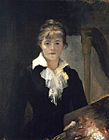






























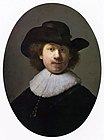








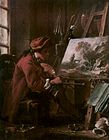



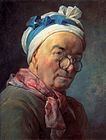


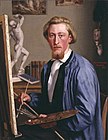














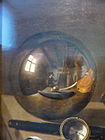








![Cristofano Allori, Judith with the Head of Holofernes, 1613. According to his biographer, the heads were those of the painter, his ex-lover, and her mother. Compare Caravaggio above.[37]](http://upload.wikimedia.org/wikipedia/commons/thumb/f/fd/Judith_with_the_Head_of_Holofernes_by_Cristofano_Allori.jpg/100px-Judith_with_the_Head_of_Holofernes_by_Cristofano_Allori.jpg)
![Van Dyck with sunflower, representing his patronage by Charles I, whose medal he holds up to the flower. Or is Van Dyck the sun the flower turns to?[38] 1633 or later.](http://upload.wikimedia.org/wikipedia/commons/thumb/e/ee/Anthony_van_Dyck_-_Self-portrait_with_a_Sunflower.jpg/120px-Anthony_van_Dyck_-_Self-portrait_with_a_Sunflower.jpg)

![Gustave Courbet, 1854, Bonjour, Monsieur Courbet. The artist has travelled to the South of France (in the vanishing coach), to meet the collector Alfred Bruyas, for whom this was painted.[39]](http://upload.wikimedia.org/wikipedia/commons/thumb/9/93/Gustave_Courbet_-_Bonjour_Monsieur_Courbet_-_Mus%C3%A9e_Fabre.jpg/120px-Gustave_Courbet_-_Bonjour_Monsieur_Courbet_-_Mus%C3%A9e_Fabre.jpg)





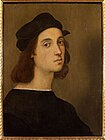

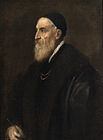








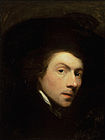
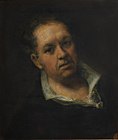



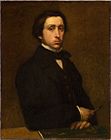



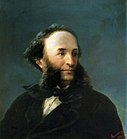
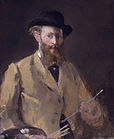


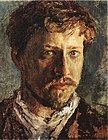



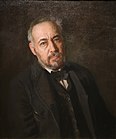







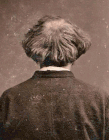
![Arthur Rimbaud, Self-portrait in Harar, Ethiopia, 1883[43]](http://upload.wikimedia.org/wikipedia/commons/thumb/6/67/Rimbaud_in_Harar.jpg/106px-Rimbaud_in_Harar.jpg)




